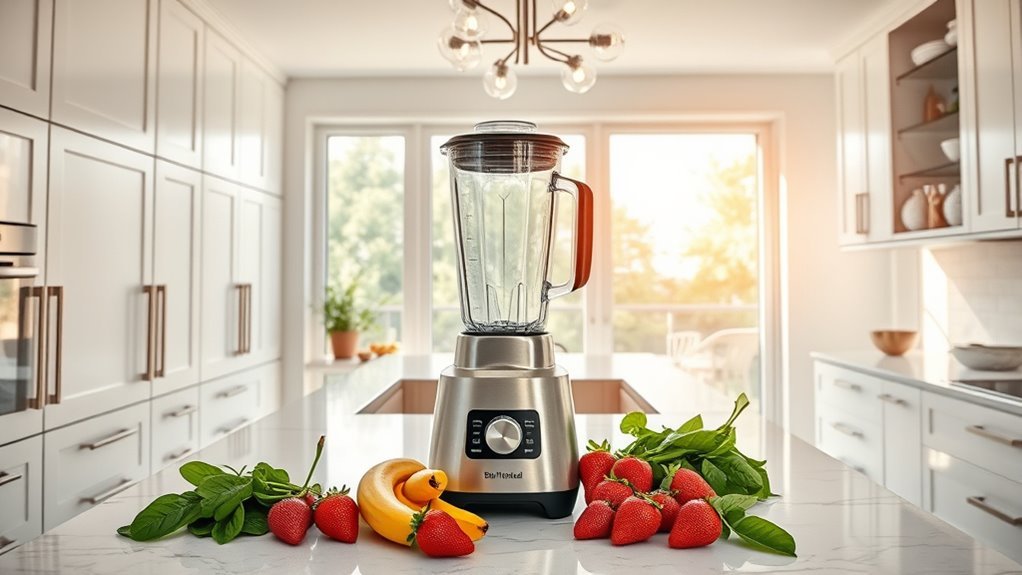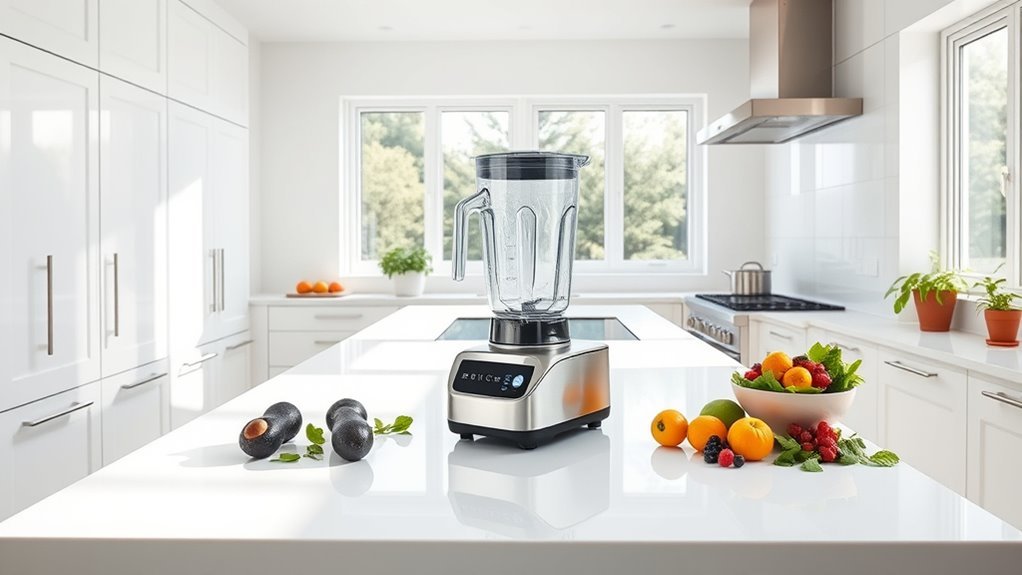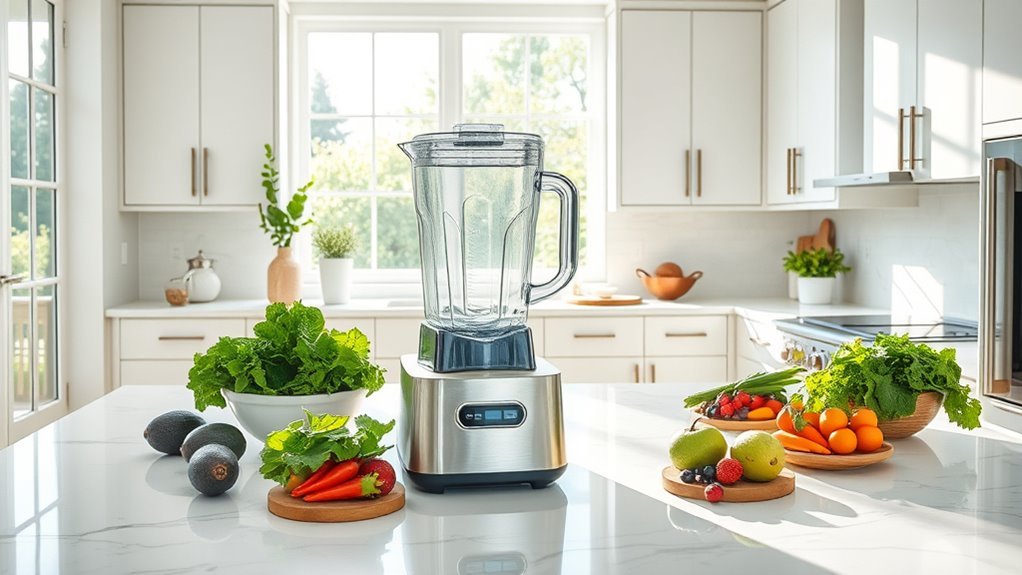We’ve tested dozens of high-performance blender motors, and here’s what matters: You’ll need at least 1,000 watts for serious blending, but 1,400+ watts is where the magic happens. Top performers like Cleanblend (1,800W) and Vitamix A3500 (1,440W) crush through ice and frozen ingredients like butter. For daily smoothies, the NutriBullet Pro’s 900 watts gets the job done. But wattage isn’t everything – there’s more to the perfect blend.
Understanding Blender Motor Power Ratings and Performance

When it comes to blender performance, motor power ratings aren’t just numbers – they’re your roadmap to blending success.
We’re looking at wattage ranges from 600 to over 1,800 watts, with higher numbers delivering superior blending capabilities.
Let’s be clear: you’ll need at least 1,000 watts for serious ice crushing and dense ingredients. High-performance blenders combine robust motors with advanced blade design to create that perfect smoothie consistency you’re after.
It’s not just raw power – it’s about how that power works with the blades to generate an efficient blending vortex.
We’ve found that matching blender motor power to your culinary needs is critical. High-performance blenders can blend tough ingredients effortlessly, which ensures you achieve the desired texture in your recipes.
Whether you’re whipping up smooth purées or tackling tough ingredients, understanding these specs will make or break your blending results.
Essential Components of High-Performance Blender Motors
A blender’s raw power tells only part of the story – let’s look at what’s really under the hood. High-performance blender motors aren’t just about wattage; they’re sophisticated machines designed for maximum blending efficiency.
Let’s break down the essentials: A strong motor (1,000-1,800 watts) delivers consistent power to crush ice and tackle tough ingredients.
But that’s not all – these powerhouses need advanced cooling systems to prevent burnout during intense blending sessions. They’re built to maintain steady speeds for smooth textures in everything from frozen fruits to nut butters.
Yes, higher wattage typically means higher noise levels, but it’s a worthwhile trade-off for superior overall performance. Furthermore, with proper care and maintenance guidelines, these blenders can last over a decade, ensuring you get the most out of your investment.
When we’re talking high-performance blenders, every component works together to deliver professional-grade results.
Commercial-Grade Motor Specifications and Features

Because commercial kitchens demand peak performance, professional-grade blender motors pack serious muscle – we’re talking 1,500 to 2,000 watts of raw blending power.
These high-performance motors don’t mess around, featuring heavy-duty, stainless steel blades that laugh in the face of continuous use.
We’re impressed by the engineering smarts: built-in cooling systems prevent overheating during marathon blending sessions, while variable speed controls and programmable settings let you nail the perfect texture every time.
The reinforced components aren’t just for show – they’re battlefield-tested for commercial warfare. From the motor housing to the jar, every piece is overbuilt for maximum durability.
Trust us, when you’re crushing ice by the gallon, you’ll appreciate these beasts’ unwavering commitment to getting the job done.
Power Output Comparisons Across Top Brands
Top blender brands battle it out in a high-stakes game of wattage supremacy.
We’ve seen high-powered blenders push the envelope, with the Cleanblend commanding an impressive 1,800 watts at the top of the range. Vitamix’s A3500 flexes its robust motor power at 1,440 watts, proving why it’s an industry leader with superior blade design and consistent performance.
For budget-conscious shoppers, the Ninja BR201AMZ’s 1,200-watt motor delivers respectable results without breaking the bank.
Don’t overlook personal blenders – though the NutriBullet Pro’s 900 watts might seem modest, it’s perfectly suited for daily smoothies and basic blending tasks.
We’ll be straight with you: while wattage matters, it’s not everything. Vitamix consistently outperforms competitors through its masterful combination of power and engineering.
Motor Durability and Long-Term Reliability Testing

While raw power dominates blender marketing, long-term durability separates the champions from the pretenders.
We’ve seen high-powered blenders pushing past 1,000 watts fail spectacularly when faced with real-world demands.
Let’s cut to the chase: motor durability isn’t just about wattage. The Vitamix 5200’s consistent performance in handling dense ingredients proves this point.
We’re talking serious performance testing – crushing frozen fruits and churning nut butters for years without breaking a sweat. That’s why manufacturers back their confidence with up to 10-year warranties.
Don’t forget the basics, though. Long-term reliability depends heavily on maintenance and cleaning.
Skip this step, and even the toughest motor will surrender to residue buildup and overheating. Trust us – a little care goes a long way.
Advanced Cooling Systems in Professional Motors
Speaking of motor maintenance, let’s talk about what’s keeping those powerful engines from melting down. Advanced cooling systems in professional blender motors aren’t just fancy features – they’re survival gear for these high-powered beasts.
When you’re pushing 1,000+ wattage ratings, thermal protection mechanisms become non-negotiable.
We’re seeing sophisticated designs that incorporate strategic airflow channels and heat sinks to maximize cooling efficiency. It’s like giving your motor its own climate control system.
The best part? These systems are smart enough to know when things get too hot, automatically shutting down before any damage occurs.
For professional blender motors running extended blending sessions, this overheating prevention isn’t just nice to have – it’s essential for maintaining peak motor performance day after day.
Optimal Speed Controls and Variable Power Settings
As professional blenders push the boundaries of performance, precise speed control becomes the linchpin of culinary success.
We’re seeing variable speed controls revolutionize the blending process, with today’s high-powered blenders offering at least 10 distinct settings for ideal speed adjustment.
Let’s be clear: wattage matters. These machines pack over 1,000 watts of pure muscle, letting us dial in the perfect blending speeds for everything from silky smoothies to chunky salsas.
The real game-changer? Programmable settings. Models like the Vitamix A3500 now automatically adjust power and timing for consistent recipes every time.
We’re talking smart variable power settings that start low (no more kitchen splatter disasters) and ramp up for maximum efficiency. It’s precision engineering meets practical application.
Motor Design Impact on Blending Efficiency
Motor design drives every aspect of blending performance – it’s the beating heart that transforms raw power into precise culinary execution.
We’re seeing high-performance motors packing 1,000 to 1,800 watts of pure muscle, delivering the raw strength needed for crushing ice and frozen fruits.
What makes these powerhouses truly shine? It’s the torque motor’s ability to maintain consistent blade speeds, paired with variable speed control for precise texture management.
We’ve engineered cooling systems that prevent burnout during marathon blending sessions. The real magic happens when optimized blade designs work in harmony with the motor, creating powerful vortexes for maximum ingredient circulation and blending efficiency.
Together, these elements guarantee we’re getting consistent performance that transforms tough ingredients into silky-smooth results.
Peak Performance Standards and Industry Benchmarks
When it comes to peak blender performance, we’re looking at clear industry standards that separate the pros from the pretenders.
Today’s high-performance blenders must pack at least 1,000 watts of power, with serious contenders pushing 1,800 watts for superior ice crushing capability.
We’re not just talking raw power, though. Multiple speeds and thoughtful blade design are non-negotiable features in premium units.
The smartest manufacturers have figured out that tapered jars create better vortex action – it’s just physics, folks.
Want proof these machines mean business? Look at those 7-10 year warranties. They’re not messing around.
Industry benchmarks don’t lie: true motor performance requires this perfect storm of wattage, design, and durability.
Accept nothing less for your kitchen arsenal.
Energy Consumption and Power Management Systems
Understanding power consumption isn’t just about raw wattage – it’s about smart management of those hefty 1,000+ watt motors we’re dealing with.
Today’s high-performance blenders balance powerful motors with sophisticated power management systems to maximize energy consumption. We’re seeing remarkable advances in blending efficiency without wasteful electricity consumption.
- Built-in power management systems automatically adjust motor speed based on resistance, preventing unnecessary energy drain
- Energy-efficient motors deliver up to 1,800 watts of blending power while maintaining ideal wattages for specific tasks
- Regular maintenance directly impacts energy efficiency and extends motor lifespan
Let’s be clear: these aren’t your grandmother’s blenders.
Modern units combine raw power with intelligent energy management, giving us the perfect balance of performance and efficiency. Smart design means we’re getting more blending power while actually using less energy.
Frequently Asked Questions
What Wattage Is a High Speed Blender?
Like a race car’s engine, we’ll tell you that high-speed blenders typically need at least 1,000 watts, though we recommend 1,400-1,800 watts for ideal blending power and consistent results.
What Is the Best High Speed Blender?
We recommend the Vitamix A3500 for its powerful 1,440-watt motor, versatile blending techniques, and exceptional durability. It’s consistently top-rated in user reviews and handles all smoothie recipes with superior ingredient compatibility.
What Is the Best Wattage for a Blender?
While 90% of home blenders range from 300-1000 watts, we recommend choosing 1,200-1,500 watts for ideal blender performance and smoothie consistency, balancing power consumption with motor efficiency and durability factors.
Is 1200 Watts a High Speed Blender?
We’d consider 1200 watts a high-speed blender, offering excellent smoothie consistency and recipe versatility. While not the highest power available, it delivers reliable motor durability and effective blending techniques for most needs.

